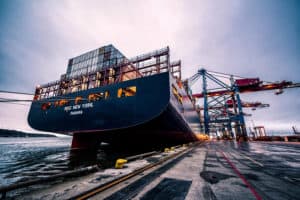Click here to get this post in PDF

With the increasing advent of globalization, there has been an escalating rise in intercontinental trade, 90% of which nowadays is transported by container ships. When it comes to container shipping market analysis two aspects play a pivotal role. The first one is the chartering price and the second is the freight rate.
Let us understand and unravel the hidden opportunities and major challenges faced by the container shipping market.
Understanding the container shipping market
In the world of container shipping, the process of hiring a cargo/container ship is called a charter. Thus chartering price refers to the specific time charter that a 1 TEU (Twenty-Foot Equivalent Unit) slot requires for carrying 14 metric ton cargo on the container ship. The freight rate is the comprehensive daily cost for delivering 1 TEU of cargo on the specified route.
From the beginning of 2000 till the last quarter of 2005, both of these prices were on high and the container shipping market was booming. However, as the great recession of 2008 approached, the freight market faced a major setback. The rates increased from 2000-2005 which after 2005 began to decline and in 2008 the rate showed a drastic decline and fell behind by 75%.
This drastic slump continued till the end of 2009 after which from the beginning of 2010 the container shipping market has been on a steady yet slow paced rise. In the last quarter of 2008 the freight rates from Asia to USA in 1000US$/TEU were recorded at approximately 1.9, whereas in the last quarter of 2009 it was recorded at 1.3. During the sharp declining phase, the freight rate on container ships traveling from Asia to the USA faced the highest setback and their rates fell to the greatest extent while the sturdiest market was that of the U.S – Europe maritime trade route.
The global market of maritime trade statistics
In terms of linear export, the Asian especially East and South East Asian countries have always played the dominant role. Such linear container exports are highly concentrated on a regional basis and thus the top ten nations account for two-thirds of the total export value. Amongst all East and South East Asian regions, Greater China i.e. the mainland China along with Hong Kong, and Taiwan control 30% of global volume of containerized shipments. While the second biggest market is in the EU where the top four players Germany, Italy, Netherlands, and Spain control most of EUs imports and exports. Germany being the leader monopolizes a huge volume of linear exports as well as imports.
Major Challenges
Some of the major challenges faced by the container shipping industry include:
- Introduction of ELD or Electronic logging devices: As 2017 marked the deadline for trucking fleets, the use of ELD came into play. The main purpose of these devices was to reduce the paperwork and streamline the trucking industry. However, with the introduction of ELD, truckers will not be able to work for unlogged hours for generating extra revenue
- NY shipping exchange: With the introduction of NYSHEX offering a list of all participating carriers, their freight rates, space availability, in transit time, and other criteria the old school negotiation and rate reduction is coming to a halt. According to some analysts, this might indirectly hinder the freight market.
- Rate volatility: There is no denying that the freight rates which were showing steady growth were recorded to be lowest in the last quarter of 2017 and have shown a further decline. Various factors such as the building of mega-ships with increasing capacity, longer transition time, development of the Trans-Siberian railroad which offers cargo delivery in one-third to half of the time of sea voyages and at reduced prices, a trade war with China and instability in global politics, all contribute to this rate volatility.
Outlook and opportunities
After analyzing different facets of the container shipping industry, one can say it faces certain obstacles of rate volatility, competition, and overcapacity. The industry might not have a promising outlook and opportunities right now. However, analysts speculate that the modern outlook should emphasize on slow and steady fleet capacity growth, improvement in transportation, as well as growth in seaborne and manufacturing facilities. All these along with mega vessels trying to outrun each other needs to be stopped, thus paving the foundation for healthy competitive markets.
Changes in traditional business outlook and modernization of the freight facilities, along with a stable world economy can generate innumerable career opportunities in this sector. The turnover will also be huge as it is still far from exploring its potentials.
You may also like: What Is the Optimal Shipping Method for Your Business?

[…] You may also like: The Challenges And Opportunities In Container Shipping Market Industry […]